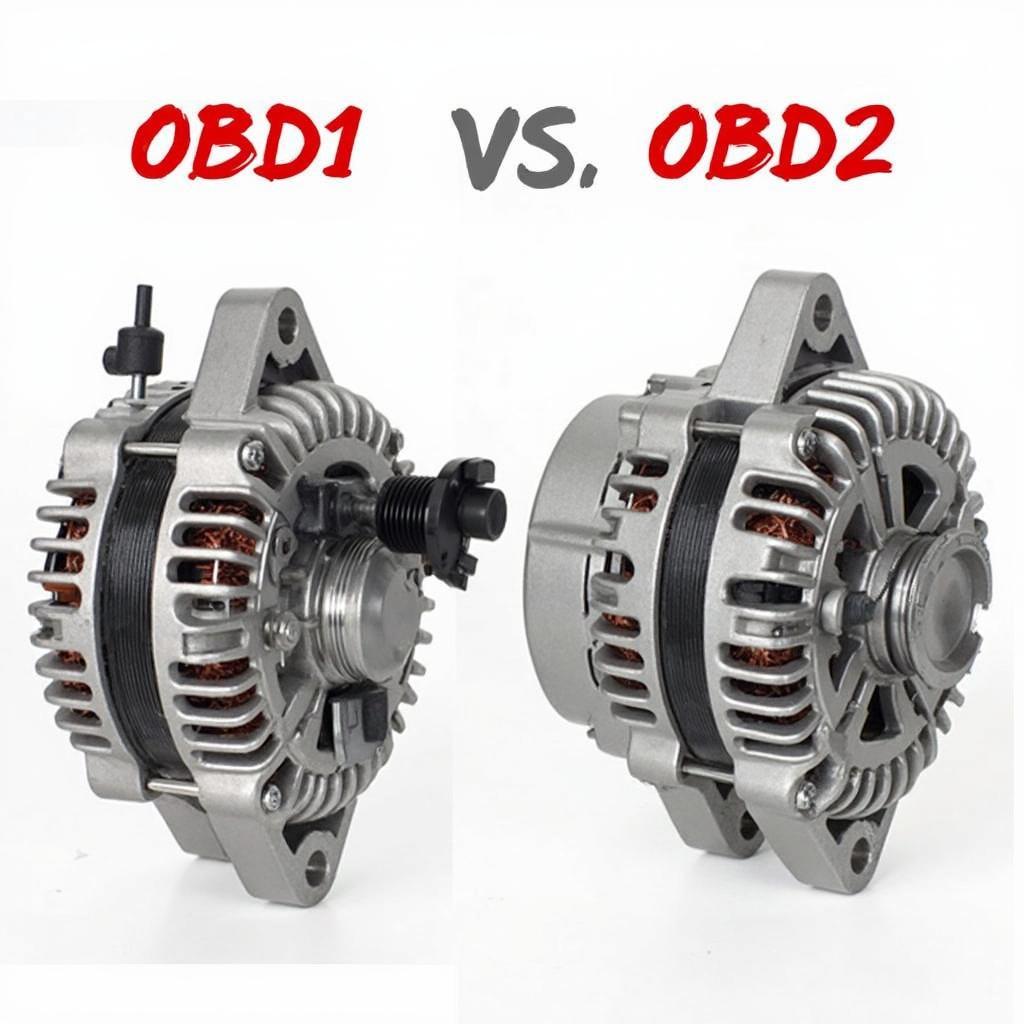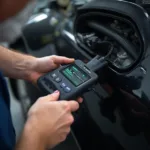Understanding the difference between OBD1 and OBD2 alternators is crucial for anyone working on older and newer vehicles. This seemingly small component plays a vital role in your vehicle’s electrical system, and knowing the distinctions between the two generations can save you time, money, and frustration down the road. We’ll explore the key differences and why they matter. innova 3140 scan obd1 obd2 scanner can be used for both OBD1 and OBD2 vehicles.
The Core Distinctions Between OBD1 and OBD2 Alternators
The primary difference between OBD1 and OBD2 alternators lies in their communication with the vehicle’s computer system. OBD1 alternators, found in vehicles manufactured before 1996, operate with minimal computer interaction. They primarily focus on charging the battery and powering electrical accessories. OBD2 alternators, introduced in 1996 and used in all subsequent vehicles, are much more integrated with the vehicle’s computer system. This integration allows for more precise control over the alternator’s output, optimizing fuel efficiency and electrical system performance.
Voltage Regulation: A Key Difference
Another critical difference lies in voltage regulation. OBD1 alternators typically use an internal or external voltage regulator. This regulator controls the voltage output of the alternator. OBD2 alternators, on the other hand, often have their voltage regulation controlled by the Powertrain Control Module (PCM), allowing for more dynamic control based on various engine parameters.
How OBD Systems Impact Alternator Function
The OBD (On-Board Diagnostics) system itself plays a crucial role in how the alternator operates. In OBD1 systems, alternator issues might not be directly detected. You might only notice symptoms like dimming lights or a dead battery. With OBD2, the system constantly monitors the alternator’s performance. If a problem arises, a diagnostic trouble code (DTC) is stored, which can be retrieved using an obd1 alternator plug to obd2 adapter for scanning. This allows for faster and more accurate diagnosis of alternator problems.
Why Does the Difference Matter?
Understanding these differences is essential for several reasons. Incorrectly replacing an OBD1 alternator with an OBD2 alternator (or vice-versa) can lead to charging system malfunctions, dashboard warning lights, and potential damage to the vehicle’s electrical system. Knowing which type of alternator your vehicle requires ensures compatibility and proper function.
Diagnosing Alternator Issues in OBD1 and OBD2 Systems
Diagnosing alternator problems differs significantly between the two systems. With OBD1, mechanics often rely on traditional methods like voltage tests and visual inspections. OBD2 systems, however, provide valuable data through the diagnostic port. This allows for a more targeted approach, pinpointing specific issues with the alternator’s performance.
“Understanding the nuances of OBD systems is paramount when dealing with alternator issues. The jump from OBD1 to OBD2 represents a significant shift in how we diagnose and repair charging system problems.” – John Smith, Automotive Electrical Engineer
Common Issues with OBD1 and OBD2 Alternators
Both OBD1 and OBD2 alternators can experience similar problems, including worn brushes, faulty diodes, and failing voltage regulators. However, the diagnostic process differs due to the level of integration with the vehicle’s computer system.
Conclusion: Navigating the Alternator Landscape
The difference between OBD1 and OBD2 alternators isn’t just a matter of age; it signifies a fundamental change in how these components interact with the vehicle’s overall system. This understanding is essential for accurate diagnostics, proper repairs, and maintaining the health of your vehicle’s electrical system. If you’re looking to upgrade your vehicle’s system, you may want to learn more about converting obd1 to obd2 ford. Understanding the difference between OBD1 and OBD2 alternators is vital for proper maintenance and repairs.
FAQs
-
Can I use an OBD2 alternator in an OBD1 car? Generally, no. The systems are not compatible.
-
How do I test an OBD1 alternator? Using a multimeter to check voltage output is a common method.
-
What are the signs of a failing alternator? Dimming lights, a dead battery, and warning lights are common indicators.
-
How do I know if my car is OBD1 or OBD2? Check the emissions sticker under the hood or consult your owner’s manual. Generally, vehicles made before 1996 are OBD1.
-
Can I convert my OBD1 car to OBD2? While possible, it’s often a complex process and may not be necessary for just an alternator replacement. Consider researching more on honda obd1 to obd2 conversion.
-
What are the benefits of an OBD2 alternator? More precise voltage regulation and better integration with the car’s computer system, often leading to improved fuel efficiency.
-
Where can I find more information on the differences between various OBD2 scanners like what are the difference of innova obd2 scanner? Research online or consult automotive forums.
You may also want to explore more about OBD1 and OBD2 systems through different resources online or specialized forums.
For any assistance or further inquiries, feel free to reach out to us via WhatsApp: +1(641)206-8880, Email: [email protected] or visit our office at 789 Elm Street, San Francisco, CA 94102, USA. We have a 24/7 customer support team ready to assist you.

